Colourful and diverse, street food is one of those travel experiences one can find in cities and towns all around the world. It's generally convenient and cheap, but its appeal goes far beyond that. Street food can be simple yet utterly delicious, and it's often a great way to sample some authentic local cuisine. Joining locals around bustling little street stalls can open doors and lead to memorable encounters. In some countries, whether you're a typical foodie or not, you may find that your search for great street food turned out to be among the best experiences of your trip.
Understand
While available pretty much anywhere, street food is most commonly associated with hot climates in general and Asian countries in particular.
This type of food is sold in urban environments and in some parts of the world along highways — in other words, places where people are moving. Markets are a good place to find a range of vendors selling street food, especially in warmer countries. There you can often go from stall to stall sampling hundreds of different kinds of food - spicy, sweet, salty, hot and cold and a range of drinks.
In colder parts of the world street food is less common, usually in a form of single food trucks, carts or kiosks where you can often choose only among variants of the same dish, e.g. hot dogs and sausages with different toppings. There, street food is almost always designed to be eaten by hand and there are seldom designated seats and tables like the ones you would find e.g. in a Singapore hawker's centre. On the other hand, at market-like events there is usually more to choose from, especially if the event is centered around food!
Eat
Street food is often not limited to just one country or region: for example, hamburgers can be found almost everywhere in the world. That does not mean that they are the same everywhere, though: street food dishes often come with a local twist. The listed foods are generally only a small sampling of what is available on the street in each place. Foods are listed according to the country or region of origin - often they can be found in the surrounding regions too.
Africa
Eastern Africa

- Mandazi - fried bread with coconut milk, eaten as a snack
- Kobo Akondro - a steamed mass of ground peanuts, sugar and flour which is sliced and eaten as a sweet
- Mofo - bread made of rice flour, many different variants
- Chipsi Mayai - the name translates to chips and eggs, and this is the Tanzanian version of the potato omelette
- Nsenene and nswaa - are grasshoppers respective ants hat are eaten as seasonal snacks
Northern Africa

- Bessara (also bsarra) - spicy fava bean soup
- Brochettes - skewered meat
- Crumbed Liver
- Sfenj - oil cooked doughnuts, common all over North Africa
- Spicy sardines
- Brik - a triangular deep-fried pastry, typically filled with egg
Southern Africa
- Boerewors - translates to farmer’s sausage, boerewors is grilled and served in a bread roll or with pap (maize porridge)
- Bunny chow - invented by the Indian community, this is a bread loaf stuffed with different kinds of curries and usually eaten by hand
- Chicken dust or Walkie talkies - barbecued chicken feet
- Gatsby - originally from Cape Town, it’s a sandwich filled with french fries and some kind of meat, fish or seafood
Western Africa
- Fufu - a kind of sticky porridge, usually made of cassava. It’s eaten by hand; formed into small balls, and dipped into an accompanying soup or stew.
- Alloco - fried plantain with chili pepper and onions

- Jollof rice - fried rice with tomatoes, onions and spices, in short a kind of vegetarian paella or pilaf
- Kelewele - diced, fried and seasoned plantains, eaten as a night or breakfast snack
- Kenkey - sourdough dumplings served with soups and sauces
- Waakye - a stew or rice and beans, usually served with some kind of meat, fish or egg
- Chin Chin - a fried hard doughnut, popular as a snack
- Kilishi - the Hausa version of beef jerk, can be made of many types of meat and is coated with a peanut paste known as Labu. Common in Hausaland (Northern Nigeria and Southern Niger)
- Suya - shish kebab made of meat or shrimp, also commonly served by the Hausa
Asia
China

- Banmian - a soup from the Hokkien speaking area made of fish stock, noodles and fish or meat. Also common in Malaysia and Singapore.
- Baozi - steamed buns with different fillings. Just the buns themselves are called Mantou, and the version filled with soup is called tangbao.
- Bing - a flatbread or pancake. A popular version is cong you bing with scallion and spices
- Chuanr - meat barbecued on skewers. This can include meats you may have never eaten before like starfish, seahorse or scorpion, but usually it's lamb or chicken.
- Douhua - tofu pudding, eaten with soy sauce.
- Dim sum - not one dish, but a variety of dumplings and rolls traditionally enjoyed with tea. Somewhat similar to Spanish tapas or Korean anju. Mostly associated with Hong Kong.
- Eggette - originating in Hong Kong, these are spherical pancakes, eaten as a snack, plain or with fruits.
- Fish balls - balls of fish paste, common in Hong Kong and in the southern Sinosphere and often accompanying other dishes
- Jiaozi - boiled, fried or steamed dumplings that can be filled with meat or vegetables. Popular elsewhere in Asia too.
- Laping - native to Tibet, this is a mung bean noodle dish with chili pepper
- Malatang - grilled meat skewers, popular in Beijing
- Shahe fen - wide rice noodles, accompanying many dishes
- Spring rolls - fried rolls with different kinds of filling and wrapping material. Common in many parts around East and Southeast Asia. Lumpia and popiah are variants of the spring roll.
- Stinky tofu - fermented tofu, usually served fried, most common in Taiwan.
- Youtiao - long deep-fried breakfast donuts, related to the Spanish churros. Rice noodles wrapped around youtiao are known as zhaliang.
- Pork chop bun - exactly what the name says, pork chop in a bun without any additional condiments
- Macau egg tart - a variation on the egg tart
Malaysia-Indonesia

- Asinan - pickled salty vegetables or fruits, eaten as a snack
- Bakwan - battered and fried vegetables
- Bakso - “Indonesian meatballs”, usually served with rice noodles. There are different variants of it, for instance they can be made of shrimp or fish, filled or skewered.
- Bubur ayam - rice porridge with shredded chicken and topped with various condiments
- Bubur cha-cha — a sweet soup made with palm sugar and coconut milk, including sago and starchy vegetables like beans, sweet potatoes, and purple yams and popular for breakfast or dessert.
- Bubur kacang hijau - a dessert porridge of mung beans, coconut milk and sugar
- Kerak telor - spicy rice omelette with coconut, scallots and shrimp
- Mee rebus - boiled noodles with a spicy sweet gravy and garnished with different vegetables
- Nasi goreng - fried rice with a range of condiments, usually served with and egg and some kind of meat and vegetables.
- Pempek - fish cakes
- Siaomay - fish or seafood dumplings
- Soto mie - spicy noodle and chicken soup


- Curry puffs are little deep-fried savory pastries with chicken-and-potato curry stuffing. These are very popular in Malaysia.
- Ais kacang, also called ABC (short for air batu campur, Malay for "mixed ice") - shaved ice traditionally flavored with red beans (kacang=bean) but there are other flavors too
- Kuih pinjaram - a flour and coconut milk snack
- Laksa - spicy noodle soup, of which many kinds exist. The most common versions are curry laksa with coconut curry, asam laksa with sour fish, and Sarawak laksa with chili, omelette, chicken strips and prawns.
- Maggi goreng - instant noodles cooked with stock of the Maggi brand
- Mee goreng are literally "fried noodles." These are typically accompanied by strips of plain omelette, bean sprouts, scallions, shrimps, and chicken or beef, but most any good ingredient on hand can be used. Various flavors exist, but in general, they are all spicy and tasty.
- Nasi goreng - fried rice, made with similar ingredients to mee goreng, or whatever good ingredients are on hand
- Nasi kandar - steamed rice served with curries
- Nasi lemak - rice cooked in coconut milk with different toppings and side dishes
- Pasembur - a seafood salad
- Roti canai — flat bread, which is typically accompanied by chicken/potato curry sauce. Roti telur has more eggs in the batter. Capati (also spelled chapatti) is also made similarly in Malaysia. There is also a sweet flatbread called roti tissue.
- Satay — usually meat (most often, chicken or beef) that's been roasted over a wood fire and put on a skewer; commonly accompanied by pressed rice (ketupat) and spicy/sweet peanut sauce. Also popular in Singapore, Indonesia and Thailand.
- Teh tarik - this is black tea with milk poured several times to give it a distinct consistency and cool it
- Durian pancake - a pancake filled with fresh durian, the signature fruit of Southeast Asia
- Hainanese chicken rice - exactly that, boiled and sliced chicken served with a ball of rice and a chili dip. Regarded as one of Singapore’s national dishes.
- Ice cream burger - a slice of ice cream wrapped in a large white bread loaf. Be sure to try the version with durian ice cream
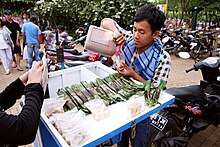
- Cendol - a dessert drink based on coconut milk and jelly rice noodles, ice and sugar
- Char kway teow - translating to stir-fried ricecake strips, it also contains seafood, chives and bean sprouts
- Otak-otak - a grilled fish cake, served wrapped in a banana leaf
- Pisang goreng - Malay for "fried bananas": battered, deep-fried bananas
- Rojak/rujak - translating to “mixture”, this is a fruit or vegetable salad of which there are countless versions
- Sup Kambing - goat soup
Middle East

- Falafel — deep-fried seasoned chickpea or fava bean balls, commonly eaten as a sandwich in a pita, with a variety of sides and sauces.
- Hummus - a dip with a very long history, made of chickpeas, sesame, lemon and garlic.
- Haleem - a stew of wheat, barley, meat, lentils and spices, which you can encounter from the Middle East to Bangladesh.
- Kibbeh - baked croquettes of ground meat and bulgur
- Murtabak - pancake stuffed with mutton, garlic, egg and onion and served with curry. It originated on the Arabian Peninsula but is popular in the Muslim world all the way to Indonesia.
- Qatayef - usually served during Ramadan, these are sweet dumplings with different fillings from cheese to raisins and vanilla
- Sfiha - the nickname “Arab pizza” is very accurate, it is defined as an open faced meat pie
- Shawarma — Slow-baked seasoned pressed meat, often turkey or lamb, which is cut into strips and commonly eaten as a sandwich including sides, as is the case with falafel.
- Ful medames - cooked and mashed fava beans, usually served with vegetables and spices
- Kushari - a kind of vegan risotto, popular among the lower classes

- Jerusalem mixed grill - barbecued and seasoned chicken offal and lamb, can be served in a bread.
- Sabich - a sandwich of egg and eggplant in a pita bread. Also available elsewhere in the Middle East, but originally from Israel.
Northeast Asia
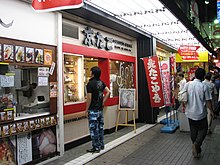
In Japan, eating on the street is normally outside the bounds of etiquette. The tremendous food courts in the basements of department stores are excellent places to get snacks, but you are expected to either eat them there or at home, not on the street. Perhaps surprisingly, 7-Eleven stores also sell good snacks in Japan, if you don't need anything fancy.
- Chikuwa - steamed sticks of ground fish, eaten as a snack
- Oden - a winter dish consisting of boiled eggs, fish cakes, soy and vegetables, but there are many varieties of it
- Consisting of small pieces of a variety of dishes, sushi can be regarded as a kind of street food even if it’s eaten inside.
- Takoyaki - battered and fried balls of octopus and vegetables
- Yakitori - skewered chicken. There are many different versions made of different parts of the animal
- Buuz - mutton or beef filled steamed dumplings, a kind of hybrid between the Chinese baozi and Russian pelmeni
- Khuushuur - fried buuz

- Anju - blanket term for snack foods enjoyed with alcohol
- Beondegi - steamed silkworm pupae
- Bungeoppang - a pastry formed like a fish that can be plain or filled; sold during the winter.
- Gimbap - Korean style sushi roll with a variety of fillings
- Goguma twigim - fried sweet potatoes served with a dip
- Hotteok - no, it isn't a hotdog but a sweet pancake.
- Jeon - pancakes that can be made with meat, seafood or vegetables.
- Mandu - large steamed Chinese style dumplings filled with meat
- Odeng - fish cakes
- Sundae - no, not a dessert but blood sausage
- Tteokbokki - chewy rice cakes (tteok) with fish cakes and sweet chili sauce poured over
Northern Indochina
- Green papaya salad - popular in Thailand as Som tam, but originally from Laos. In addition to papaya it includes lime, chile, fish sauce and pal sugar
- Kuy teav - a noodle soup with meat and various vegetables, usually eaten for breakfast
- Num banh chok - rice noodles with curry gravy
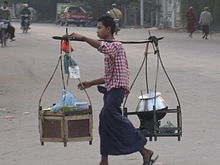
- Mohinga - a fish soup with fritters and noodles, traditionally eaten as a breakfast

- Khanom bueang - crepes filled with coconut cream
- Khao soi - “cut noodles” is a soup of noodles and meat in curry sauce, native to the northern parts of Thailand plus Laos and Myanmar
- Pad Thai is the most famous street food of the Chao Phraya Valley and Bangkok. It consists of noodles with pieces of plain omelette, bean sprouts, peanuts, birds eye chilis, shrimp, and various other ingredients.
- Phat si io - a stir fried noodle dish, somewhat similar to char kway teow further south
- Tom yum - a spicy and sour salad-based soup with fish sauce and herbs

- Banh canh - it’s name translates to soup cake. The “cake” part is a lump of noodles in the middle of the soup, which can be made with meat, seafood or fish.
- Banh hoi - bundles of rice noodles topped with garlic and scallions
- Banh mi. This uniquely Vietnamese sandwich, typically of roast pork with various vegetables, cilantro, birds eye chilis, paté and mayonnaise on a baguette made with mixed wheat and rice flour and also available with chicken instead of pork and several other variations, is a common street food in Vietnam.
- Banh xeo - pancakes made of rice flour and turmeric and stuffed with pork, shrimp, onion and bean sprouts.
- Bun cha - grilled pork with rice noodles
- Pho - noodle soup with herbs and chicken or beef
Philippines
- Balut - boiled egg with a developed chick embryo inside
- Banana cue - bananas coated with sugar and deep fried on skewers
- Camote cue - sweet potatoes coated with sugar and deep fried
- Ginanggang - grilled skewered bananas covered in margarine
- Isaw - barbecued pig or chicken offal
- Kikiam - a type of processed chicken and pork, served on a stick with a variety of dipping sauces
- Lomi - a noodle soup with sauteed meat, garlic and shallots
- Maruya - battered and deep-fried banana pieces
- Proben - deep fried chicken pieces with a vinegar dip
- Sinangag - fried rice with garlic, usually accompanies meat dishes
- Taho - a tofu and syrup snack served in a cup
- Tokneneng - hard boiled eggs battered and deep fried. The version where quail eggs are used is known as kwek kwek.
- Turon - a sweet kind of spring roll, eaten as dessert. It is filled with bananas, jackfruit and brown sugar
South Asia
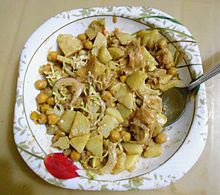

- Appam/hoppers - pancakes made of fermented rice batter, eaten in Southern India and Sri Lanka
- Biryani - the South Asian risotto, believed to have originated in Hyderabad. As with other dishes in this region, there’s a wide variety in the meats, vegetables and spices used.
- Chaat is a catchall term for small savory dishes. Chaat comes in many varieties and regional variations and is sold on the street throughout India, Pakistan and Bangladesh.
- Falooda - a cold beverage made of syrup, pasta, basil, gelatin and tapioca
- Jalebi - deep fried batter “worms” eaten as dessert, a bit similar to the American funnel cake or Finnish tippaleipä
- Kachori - flour balls filled with beans and spices eaten as a snack
- Khaar - rice pudding eaten for dessert
- Kulfi - ice cream which has not been whipped and is therefore denser
- Lassi - a yoghurt-based beverage
- Panipuri/phuchka - deep fried filled flour balls

- Aloo chaat - deep fried potatoes with aloo chaat spice.
- Bhelpuri - puffed rice topped with sev noodles, masala and chutney. Popular in Mumbai.
- Chole bhature - spicy chickpeas and bhature bread
- Flatbreads - naan, chapati, paratha and roti are common types of Indian flatbread, which you will encounter at many meals in India as a side or as a wrapper.
- Dahipuri - puri bread stuffed with mashed potatoes or chickpeas and served with chutney
- Dosa - a fermented pancake of rice and black lentils, stuffed with different vegetables and served with chutney
- Kati roll - today almost anything wrapped in a flatbread can be called a kati roll, however when the dish was invented in Kolkata it was filled with skewered chicken and mutton meat.
- Sevpuri - puri stuffed with diced potatoes and onion and served with chutney. Garnished with sev noodles.
- Pakora - deep fried chickpea snacks
- Papri chaat - fried flour wafers with boiled potaoes, yoghurt, chutney and spices, popular in the northern part of the country.
- Pav bhaji - bread rolls with a potato-based curry
- Samosa - fried or baked pastries that are filled with a mix of vegetables or some kind of meat. Can be served with chutney or yoghurt. Common from Bangladesh to the Middle East and East Africa.
- Vada pav - a kind of vegetarian burger with deep fried potato croquettes and chili
- Momo - a type of steamed or fried filled dumpling, similar to the Chinese baozi.
- Kottu - a heated mix or roti bread, egg, meat, vegetables and spices
Turkey

- Börek - a pastry filled with cheese, minced meat or vegetables. It’s popular also on the Balkan, Caucasus and in parts of the Middle East, however böreks there look a little different.
- Boza - a thick, fermented beverage
- Gözleme - a baked pastry filled with meat or cheese
- Kebab - sliced meat (beef, chicken or lamb). It's commonly served with a bread roll, rice or salad. It is popular both throughout the Middle East and in the Western world. There are many different versions of kebab.
- Kokoretsi - skewered lamb and goat offal served in or on a bread
- Köfte - Turkish meatballs
- Kumpir - originally from Istanbul, this is a baked potato filled with cheese or vegetables
- Lahmacun - a round bread topped with meat, sometimes called the “Turkish pizza”
- Lokma - dessert syrup doughnuts, which can be fried or deep-fried
- Simit - sesame pretzels, also popular in nearby countries
Europe
Benelux and the British Isles
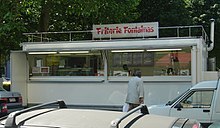
- Frikandel - a deep-fried sausage of minced meat
- Mitraillette - a baguette stuffed with meat, french fries and sauce
- Pommes frites (sometimes called "French fries" in other countries) - So-called "French fries" actually originate in Belgium. In Belgium they can be served together with a sauce or mayonnaise or with mussels (moules-frites). For a really local fast food experience, head to a friterie kiosk with a variety of foods served deep fried.
- Waffles

The Dutch have adopted several types of foreign street foods as their own, and Vietnamese spring rolls, Döner kebab and falafel are available from small stalls in most cities.
- French fries are highly popular as food to go, available from small restaurants as well as street stalls. Sometimes covered with sauces or even as kapsalon, which means covered with sliced meat, cheese and salad. Fries are typically accompanied by a wide range of deep fried snacks, such as kaassoufflé (a bread-roll filled with cheese), berenklauw (deep fried skewer with meatballs and onion rings served with satay sauce) and many others.
- Soused herring - herring marinated in vinegar that is served as such or in a sandwich with diced onion
- Stroopwafel - the syrup waffles are a dessert snack and originate from Gouda
- Cornish pasties are a type of meat pie, traditionally made with steak, potatoes, and plenty of onions
- Fish & chips - deep fried battered fish pieces (usually cod) and potatoes (French fries)
- Sandwich - originally named after the 4th Earl of Sandwich, today few know that one of the most widespread street foods in the western world originates in England.
- Sausage roll - exactly what the name says, a sausage baked into a pastry
Central Europe
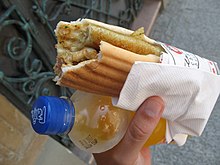
- Bosna - the local version of the hotdog made with grilled white bread, a bratwurst and more spices
- Smazeny syr - breaded and fried cheese, sometimes served in a bun and usually accompanied with a tartar sauce dip

- Currywurst - boiled sausage cut into slices and drowned in a sauce of ketchup and curry, often served with a bun. Invented in Berlin still popular there and anywhere, where a large crowd of blue collar workers may be found, such as the Ruhr area and the VW plant in Wolfsburg
- Döner - Döner Kebab originates from Turkey, but since the arrival of Turkish "guest workers" in Germany in the 1960s, this savory sandwich or platter of slow-roasted pressed, seasoned lamb and various sides has been embraced by practically the entire German nation.
- Sandwiches (German: Belegtes Brot, American style Sandwiches are called "Sandwich" in German as well) - great almost everywhere in Germany, including most shops in airports and train stations, because they are made on German bread, which is among if not the best than certainly the most varied in the world, and almost always use fresh ingredients for filling. They can however be a bit expensive (even for local tastes) at some bakeries in "strategic locations".
- Sausages - Many types of Wurst (sausage, German plural "Würste") are frequently sold on the street and in informal eateries called Imbiss (sometimes spelled Imbiß) in Germany. Bratwurst (there are several subtypes named for the region where they originate, the most common being Thüringer [from Thuringia] and Nürnberger [from Nuremberg]) is fried while Bockwurst and Weißwurst (literally white sausage. Traditionally eaten before noon in a "Weißwurstfrühstück") are boiled. The latter is native to Bavaria and is often served with a pretzel instead of a bun. The traditional condiment for a Weißwurst is "sweet" mustard.
- Kürtöskalacs - a sugar-coated pastry, baked on a spit, also known as “chimney cake”
- Lángos - deep fried flatbread with garlic and different toppings. Originally from Hungary, they can now be found in Austria, Slovakia or even Germany as well. In some places they are only available on special occasions
- Pierogi - baked or fried dumplings filled with meat, potatoes, cheese or vegetables. Common all over Central and Eastern Europe.
- Zapiekanka - a grilled baguette with cheese, mushrooms, ketchup and sometimes ham
- Richman - this specialty from Bratislava is a sandwich with cheese, cabbage, mayonnaise and sometimes meat
Former Soviet Union
- Khorovats - barbecued meat skewers

- Chiburekki - a half-moon shaped meat-filled pie, encountered as street food in the western half of the former Soviet Union.
- Kvas - a drink of fermented bread with low alcohol content. Popular on hot summer days.
- Pirozhok (pl. pirozhki) - small pies (pirog are the larger ones for sharing) that can be filled with either meat, vegetables, cheese, cabbage or various sweeter stuff. In Russian cities like St. Petersburg there are kiosks selling these in addition to donuts, other snacks and various beverages.
- Shashlik - skewered meat and vegetables, Cossack style. Common also in Western and Central Asia.
Mediterranean Europe

- Crêpes - these fine pancakes are not just a dessert at fine dining places. You can get it from street stalls with a variety of toppings, both sweet and salty, or plain if you wish.
- Galette-saucisse - a grilled sausage wrapped in a galette (a kind of crepe). Native to the Brittany region.
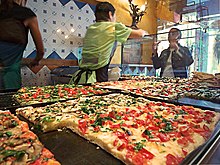
- Arancini - a Sicilian specialty, fried balls of rice filled with meat and tomato sauce
- Calzone - this is a folded pizza, resembling a half moon. A smaller version is known as panzarotti.
- Farinata - chickpea pancake from Liguria
- Gelato - the Italian version of possibly the most popular street snack in the world contains more sugar and fat and is softer than ordinary ice cream.
- Pani ca meusa - another Sicilian specialty, a sort of meat pie of vastedda bread with offal filling
- Panino - a grilled sandwich. A variety of different fillings are possible, but a classic combination could include some type of meat (such as mortadella, prosciutto crudo, salami or bresaola), cheese (such as fresh mozzarella, provolone or a local type of pecorino) and vegetables (such as tomatoes, eggplant, zucchini, mushrooms, fresh basil)
- Piadina - flatbread filled with cheese, meat, vegetables or jam. Native to the Romagna region.
- Pizza - a flat bread baked in an oven, usually topped with at least tomato sauce and cheese, but you can find pizzas with almost anything on them. However, pizza is traditionally eaten in Italy in sit-down establishments, with knife and fork, and Neapolitan pizza is too saucy to attempt to eat on the street. The same may not be true of some of the pizza further north, like for example the Genovese sardenara. Hand-sized takeaway pizza is referred to as pizza al taglio - pizza by slice.
- Scaccia - a folded flatbread commonly stuffed with cheese, tomato sauce and onions
- Stigghiola - seasoned lamb guts grilled on skewers
- Pastizzi - cheese-filled pastries

- Buñuelo - fried donut balls, popular all around Latin America and in Morocco too.
- Churros - deep-fried long “doughnuts”, served for breakfast with chocolate sauce
- Empanadas are stuffed dumplings made from wheat flour. Apparently invented in Leon, they can be encountered in all of the former Spanish Empire and beyond - with different kinds of stuffings.
- Paella - rice with seafood, fish, meat and spices - it's made in a large pan and there are many different versions of it
Southeastern Europe
- Gyro - the Greek variant of kebab, served in a pita bread with vegetables and tzatziki sauce.
- Souvlaki - meat and vegetables grilled on a skewer, can also be served with or in a pita bread
- Pljeskavica - beef with french fries, sometimes served as a hamburger
- Raznjici - grilled kebab meat on skewers
- Pølse - the hot dog was not invented in Denmark , but hot dog wagons (pølsevogn) are ubiquitous. A typical Danish hot dog is topped with mustard, ketchup, remoulade sauce, roasted onions and pickle relish. Fransk hot dog (French hot dog) is a version where the sausage is stuffed from the end into a small baguette so that just a part of it is visible and has less toppings.
- Smørrebrød – Literally buttered bread, but much more than that. A Danish smørrebrød is a slice of bread topped with either fish, seafood or meat plus various vegetables and sometimes remoulade or sliced boiled egg. Often the toppings are overflowing the bread, wherefore it should be eaten by fork and knife. Depending on where you draw the border, this may or may not count as street food.

Street food and fast food are overlapping concepts in Finland. The best place to find Finnish street food would be at "grill" kiosks that you usually find in both in bigger cities and smaller towns. Their menus usually include different versions of hotdogs, meat pies, hamburgers, chopped sausage with fries (makkaraperunat), the porilainen and such. In the summer, market squares in mid-sized and small cities usually have a market day every week or even more often where you can have some fried sausages, fried vendace and sometimes Middle Eastern and Asian street food. Four days a year an event called the Restaurant day takes place. For one day, anyone is allowed to open a pop-up restaurant without the otherwise strict restrictions to open a restaurant which in practice means a lot of small street food tables popping up in city parks.
- Lihapiirakka - literally "meat pie". The Finnish version is deep-fried and flat, filled with minced meat and rice, sometimes a sausage is added.
- Mustamakkara - literally "black sausage", and as you might guess it is made of blood. This specialty of Tampere is enjoyed with lingonberry jam and milk.
- Paistettuja muikkuja - fried vendace is a frequent encounter on summer markets, especially in the Finnish Lakeland
- Porilainen - a fusion of Pori and hamburger, this consists of two slices of bread and a thick slice of sausage as a "beef". It's usually served with a mix of ketchup, mustard, diced onion and cucumbers.
- Kjötsúpa - often signposted with its English name "meat soup", you can get this piping hot soup from food trucks around downtown Reykjavik. Made with lamb meat, they also offer a vegetarian version of it which is the same soup without the meat.
- Tunnbrödsrulle - Traditional “thin bread” wrapped around a sausage and potato mash.
North America
In some cases the boundary between street food and fast food in North America is fluid.
Canada

- Beaver tail - a fried flat pastry which is topped with sweet condiments
- Garlic fingers - a kind of pizza topped with cheese and garlic and cut up in strips instead of slices
- Poutine - French fries with gravy and cheese curds poured over them. Originated in Quebec, but now popular throughout the country.
Caribbean
- Keshi yena - steamed or baked cheese balls stuffed with meat, typically chicken
- Yaniqueques - deep fried cakes, a derivative of the johnnycake from New England and a popular beach snack
- Jerk Chicken - chicken rubbed with jerk spice mix and cooked over fire
- Patties — savory pastries filled with chicken/potato curry, beef, callaloo, mixed vegetables, or other fillings

- Alcapurria - balls of dough of tubers, bananas and plantains stuffed with meat and fried
- Bacalaíto - battered and deep-fried cod
- Sorullos - fried cornmeal sticks
- Aloo pie - a samosa pastry filled with mashed potatoes and other vegetables and served with a chutney
- Doubles - flatbread filled with curried chickpeas and topped with fruit
Central America

- Pupusas - tortillas filled with cheese, pork meat and beans
- Baleada - the Honduran version of the tortilla, traditionally filled with fried beans and folded in half
- Quesillo - tortillas filled with cheese, onions and sour cream
- Food that you can get at a fritanga sometimes simply called frito usually including grilled meat (beef, pork or chicken) tajadas or tostones (made from plantains) and coleslaw
Mexico


- Aguas frescas - translating to “fresh waters”, these are sugary water flavored with various fruits, seeds, cereals and flowers.
- Bionico - a Mexican fruit salad
- Chalupa - a platter of tostada (fried tortillas) formed into a cup and filled with meat, onion and salsa
- Elote - boiled or grilled corn on a cob
- Empalme - this Nuevo León specialty is a grilled sandwich of two tortillas with lard, beans and salsa
- Enchilada - a tortilla wrap covered in spicy sauce
- Esquites - boiled corn topped with cheese, chili and sour cream and served in a cup
- Gordita - maize cake stuffed with cheese and meat
- Menudo - a soup made with beef tripe and chili
- Paleta - ice pops of fresh fruit
- Pozole - a stew of maize, meat and chili
- Tacos exist in many varieties, with al pastor (made with marinated pork) perhaps the most famous, but also including chivo (goat), lengua (tongue), carne asada (shredded beef), and quite a few others. Taco trucks also exist in the United States, especially those portions that were part of Mexico before the Mexican-American War (including California, New Mexico, Texas, and Colorado). A burrito is not very different from a taco, but the contents are completely enclosed. Stuffed with cheese, they are known as quesadillas. Smaller versions that are fried, remotely reminiscent of spring rolls, are known as taquitos.
- Tamale - masa dough dumplings cooked in banana leaves. Also common in Central America and parts of the Caribbean
- Tejuino - a fermented corn beverage serve cold with sorbet on the top
- Tlayuda - a dish with a tortilla used as a plate, on which there’s meat, vegetables, beans and avocado
- Torta - the Mexican expression for “sandwich”, with the second part of the name revealing what it’s filled with, commonly some kind of meat, egg or avocado
- Tostilocos - tortilla chips topped with pork, peanuts and various spices
United States

- Chimichanga - deep-fried burrito, originating in Arizona or New Mexico
- Hamburger
- Honey-roasted nuts
- Hot dog
- Knish - baked, grilled or deep fried pies that can be filled with potatoes, kasha (buckwheat), meat, cheese or vegetables. Popularized by Eastern European immigrants in New York.
- Korean taco - truly a fusion street food, tacos filled with bulgogi, kimchi and other Korean food
- Lobster roll - like a hot dog, but with lobster meat and mayonnaise instead of the sausage and mustard
- Pilgrim - a sandwich with turkey, cranberries and cheddar cheese
- Po’boy - a submarine sandwich from Louisiana consisting of baguette topped with roast beef or fried seafood
- Salt pretzels
- Steak sandwich - a bread roll with steak and different kinds of toppings. One of the best known versions is the Philly Cheesesteak with steak and melted cheese, often topped with diced onions, mustard and ketchup.
Oceania

- Australian meat pie - a pie filled with minced meat and gravy, often topped with mashed potatoes and peas.
- Pie floater - when the above meat pie is served floating in a bowl of pea soup, common in Adelaide
- Sausage sizzle - the hot dog has an Aussie cousin too. The sausage sizzle is barbecued sausage served on slice bread with different toppings.
- Ota ika/ika mata - raw fish that’s been marinated in citrus juice, spices and coconut milk, similar to the Peruvian ceviche
South America
Andean countries
- Salteña - the Bolivian version of the empanada stuffed with beef, pork or chicken and a spicy sauce.
- Hornado - roast pork served with fried potato cakes (llapingacho) and maize
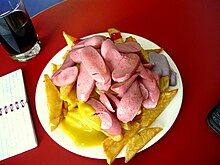
- Anticuchos - the Peruvian version of satay
- Humita - paste made from fresh grated maize corns, boiled wrapped in corn husks, and turned into a dumpling. It can be combined with lard and salt and fresh cheese for a savory dish or with sugar, cinnamon and raisins for a sweet dish. Savory humitas may also be prepared with anise.
- Papa rellena - stuffed potatoes, commonly stuffed with beef, onions, eggs and vegetables
- Picarones - donuts with squash and sweet potato
- Salchipapa - a mix of fried sausages and potatoes with coleslaw and chili
Brazil

- Açaí na tigela - a smoothie of the thick creamy purple juice from the grated fruit of the açaí palm (Euterpe oleracea), topped with other fruits
- Acarajé - deep-fried balls of black-eyed peas, originating in Africa.
- Cachorro Quente - hot dog, often topped with green peas, maize and french fries
- Coxinha - meat (usually chicken meat) formed into a cone and deep-fried
- Pamonha - made with grated maize, identical to Peruvian humita
- Pão de queijo - these “cheese breads” are eaten for breakfast
- Pastel: deep-fried pastry filled with cheese, minced meat or ham
- Tapioca (or more precisely, "beiju de tapioca"): made with the cassava starch, also known as tapioca starch. When heated in a pan, it coagulates and becomes a type of pancake or dry crepe, shaped like a disk. Some will serve it folded in half, others will roll it rocambole-style. The filling varies, but it can be done sweet or savory, with the most traditional flavors being grated coconut/condensed milk (sweet), beef jerky/coalho cheese, plain cheese, and butter (savory). However, in recent times it has become a "gourmetized" food item, to be treated with creativity; nutella, chocolate, napolitano (pizza cheese/ham/tomato/oregano) and shredded chicken breast/catupiry cheese being almost standard options nowadays.
Northern South America
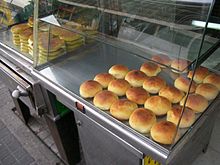
- Aborrajado - deep fried plantains stuffed with cheese
- Almojábana - corn and cheese bread
- Granizado - a drink of shaved ice, sweet milk and syrup
- Natilla - a custard dessert, usually eaten around Christmas
- Salpicon - a fruit cocktail
- Arepas, which are essentially stuffed corn-flour dumplings, are a specialty of Venezuela.
- Cachapa - corn pancakes, traditionally eaten with queso de mano (“hand-made cheese”)
Temperate South America

- Choripán can be considered the hot dog's South American cousin. It is a grilled lengthwise cut chorizo in a baguette with chimichurri sauce poured over it.
- Completo - a Chilean version of the hot dog with chopped tomatoes, mayo and sauerkraut
- Sopapilla - fried flat donuts that are also popular elsewhere in Latin America
- Chivito - a larger version of hamburger where the beef is replaced with a steak and with many more toppings, always including a fried egg.
Drink

Street food is often eaten in warm climates, hence cooled soft drinks, water, fruit juice or beer are the most common beverages to drink together with this kind of food. Some drinks can also be considered street foods in themselves, for example Kvas, a fermented beverage with low alcohol content sold from stalls in Russia, Ukraine and other parts of Eastern Europe. Warm beverages such as coffee or tea are common with pastries or when it is cold outside. In Germany, Scandinavia and the Baltic States, a highlight of Christmas markets are the stalls selling Glühwein (mulled wine) to warm you up.
Stay healthy
Understand that street food vendors do not necessarily have the same standard of hygiene as sit-down restaurants and cafés. Food that has been handled carelessly can carry bacteria, Hepatitis virus and other things that can upset your stomach and possibly even develop into something worse. You should be careful with food that has been sitting around for a long time. It is best if your food is prepared after you've ordered it and served hot. Generally speaking stalls with a high number of customers in a given time are more likely to serve fresh produce and less likely to have the food lying around too long.
Respect
It's a good idea to look at how other people eat; otherwise, the food might end up everywhere but in your mouth and/or you will make a spectacle of yourself. The latter would include eating with chopsticks with absolutely no prior experience, eating with your hands when nobody else does or eating with your left hand in Muslim countries where it is considered dirty.
